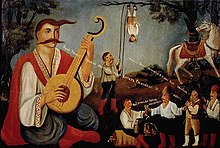Haydamak
This articleneeds additional citations forverification.(September 2016) |

Thehaidamakas,alsohaidamakyorhaidamaks(sg.haidamaka;Ukrainian:Гайдамаки,Haidamaky) wereUkrainian Cossackparamilitary outfits composed of commoners (peasants, craftsmen), and impoverished noblemen in the eastern part of thePolish–Lithuanian Commonwealth.They were formed in reaction to the Commonwealth's actions that were directed to reconstitute its orders[clarification needed]on territory ofright-bank Ukraine,[1]which was secured following ratification of theTreaty of Perpetual Peacewith theTsardom of Russiain 1710.
Etymology and terminology[edit]
Etymology[edit]
The wordhaydamakhas two related meanings: either 'Ukrainian insurgent against the Poles in the 18th century', or 'brigand'.[2]The role played by haydamaks in the anti-Polish Ukrainian revolts of the 18th-century led byMaksym ZalizniakandIvan Hontaled to the first meaning.[2]
The word has been adopted into Ukrainian from theCrimeaand the neighbouring region, where it has been used in someKipchak,OghuzandSlavic languages.[2]The origin is theTurkicword 'haydamak', 'to drive, to drive away', the etymological vehicle being theOttoman Turkish.[2]The verb (h)ayda was probably derived from theonomatopoeicstemused to spur someone on: 'hayda!'.[2]Depending on the local context, it was understood to mean 'driving someone or something away', and later 'to chase, to pursue'.[2]In theinfinitiveTurkish verbs have the ending -mak or -mek.[3]The ending -ak(a) however also exists in Ukrainian, in words with meanings somewhat related to each other, such ashuljáka,'crouser' (crouse = brisk, livelyl, confident),pyjak(a),'drunkard',rozbyšaka,'brigand', and that might have led to the initial meaning of 'to chase, to pursue' evolving to mean 'chaser, pursuer', and finally 'insurgent'.[2]In different other languages the meaning of 'brigand' given to hajdamak(a) took shape in accordance to the way their enemies saw thehajdamaks.[2]
In Ottoman Turkish, haydamak used to mean "a cattle-lifter, marauder",[2]and in modernTurkishit means "to attack, raid, drive cattle".[3]
Older Ukrainian terms[edit]
Other more ancientexonymsof the same haidamaks includelevenetzanddeineka.[4]Equivalents ofhaidamakaincludeopryshokin UkrainianGalicia.[clarification needed]
In other languages[edit]
TheRomanianwordhaidamacmeans 'strong, sometimes no-good man'.[5]
The wordshajdukused inCentral Europeand theBalkanshas a similar meaning.[2]
Historical connotations[edit]

Because of the massacres ofJews,Jesuits,Uniates,and Polish nobility, thePolish languagetermHajdamactwobecame a pejorative label for Ukrainians as a whole. However, Ukrainian folklore and literature generally (with some notable exceptions) treat the actions of the haidamaks positively.Haidamaky(1841), anepic poembyTaras Shevchenko,treats its subjects both sympathetically and critically.
History[edit]
The haidamak movement consisted mostly of local freeCossacks(not members of anyhost) and peasantry (kozakyandholota), and rebels.[citation needed]
Haidamaks waged war mainly against the Polishnobilityand collaborationists inright-bank Ukraine,though the movement was not limited to the right bank only, and they participated inZaporozhianraids on the Cossackszlachtain left-bank Ukraine as well. The latter raids occasionally deteriorated to common robbery and murder, for example in the so-calledMatsapuracase in the Left Bank in 1734.[6][7]
Opposition to theszlachtaand toRoman Catholicsled to the haidamaka rebellions (haidamachchyna). Three major uprisings took place, in 1734, 1750, and the largest – usually referred to asKoliyivschynain 1768.
The first uprising came in the war for control of thePolish Kingdomin 1734 after the death ofFrederick Augustus IIin 1733. Russian troops, brought in to remove KingStanisław I (Leszczyński),were initially seen[by whom?]as liberators from the Poles, and an insurrection developed inKiev,spreading toPodoliaandVolhynia.AfterAugustus IIIgained the throne of Poland-Lithuania in 1734, the Russian military suppressed the insurrection. Small raids by haidamakas against Polish nobility continued in the following years under the leadership ofHnat Holy.[8]
In 1750 another uprising occurred as the haidamakas continued to receive popular sympathy. Based in the lands of theZaporozhian Cossacks,they moved into the south of theKievPalatinate,generating a near-complete rebellion by Right-Bank Ukraine. Although they captured a number of towns and areas, they were eventually crushed[by whom?]due to lack of organization.
In 1768, led byZaporozhianCossackMaksym Zalizniakand leader of theUmanCossack paramilitary groupIvan Gonta,the peasants were initially successful in conquering much of theKievandBracław Voivodeships,as well as large chunks ofVolhyniaandPodolia.In captured territories the nobility,Ukrainian Catholics,Jesuits and above all the Jews, were murdereden masse(seeMassacre of Uman), which led to a quick response by the Polish army. By July of the same year the Poles – with Russian military assistance – had suppressed the revolt, though bloody repression against the Cossacks lasted for several years. SeeKoliyivschynaarticle for more details.
The last flare-up of the Haydamak violence occurred in 1830s, during theUstym Karmaliukrebellion. This final chapter of Haydamaka history was unique in large part due to the support the rebellion enjoyed not only among the peasantry, but also among the Poles and the Jews marginalized and rendered destitute by the Russian Empire.
Cultural depictions of haidamaky[edit]
- Taras Shevchenkopublished poemHaidamaky(1841).
See also[edit]
- Hajduk
- Ustym Karmaliuk(1787–1835), Ukrainian outlaw, the "Ukrainian Robin Hood" or "the last haydamak"
- Khmelnytsky Uprising1649–1657
References[edit]
- ^Haidamaka movement (ГАЙДАМАЦЬКИЙ РУХ).Encyclopedia of History of Ukraine
- ^abcdefghijNémeth, Michał (2005)."Remarks on the etymology of Hung. hajdú 'herdsman' and Tkc. haydamak 'brigand'".pl:Studia Turcologica Cracoviensia(10). Krakow: Jagiellonian University: 297-309 [304].Retrieved22 September2020.
- ^abMorison, W. A. (1941)."Some Aspects on the Non-Slav Element in Serbo-Croat".The Slavonic Year-Book.1, American Series. Cambridge University Press: 239-250 (241).doi:10.2307/3020262.JSTOR3020262.Retrieved26 September2020.
- ^ Я. Шульгин, «Очерк Колиивщины» (Киев, 1890)
- ^"Dexonline".Dexonline.ro.Retrieved17 September2016.
- ^Oles Buzina."Людоед Мацапура –" Чикатило "XVIII столетия (фото)".Segodnya.ua.Retrieved17 September2016.
- ^A horror story from the Cossack Hetmanate: The crimes and execution of Pavlo Matsapura’s gang that inspired an 18th-century word for villain
- ^Holy, Hnat
External links[edit]
Articles in theInternet Encyclopedia of Ukraineof theCanadian Institute of Ukrainian Studies:
